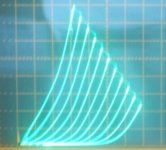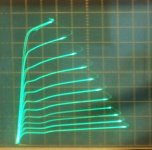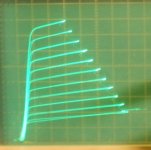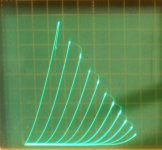Hi Guys
Been reading this site for a while now on and off great site btw!
I need a design from top to bottom of a push pull amplifier using 2 833 tubes for each channel im trying to achieve 200wpc preferably mono blocks i know these involve a lot of high voltages and many people will try and talk me out of this please dont lol! the 833 tube is my tube of choice i will be using these mono blocks to power a pair of Kef Reference 4`s these cabs are rated at 400watts supposedly!? (and i understand valve power is different to solid state).
if anybody could point me in the right direction as to a complete DIY i will be very please .
.
Been reading this site for a while now on and off great site btw!
I need a design from top to bottom of a push pull amplifier using 2 833 tubes for each channel im trying to achieve 200wpc preferably mono blocks i know these involve a lot of high voltages and many people will try and talk me out of this please dont lol! the 833 tube is my tube of choice i will be using these mono blocks to power a pair of Kef Reference 4`s these cabs are rated at 400watts supposedly!? (and i understand valve power is different to solid state).
if anybody could point me in the right direction as to a complete DIY i will be very please
Two 833 tubes in push pull will give you nearly 2000 watts of output. Do you know how much filament current an 833 draws? Can you source sockets for them? Have you looked at airflow requirements? There is no how to guide for building the amplifier that you want. Sorry to sound cold here but this is not a weekend project.
i wanted to basically run them at half power so they last a whole lot longer and from what ive been reading push pull is easier to get a better sound from due to sourcing decent opt, yes i belive the 833 draws 10a doesnt it? i have seen a few of these sockets on ebay, im more than willing to put the time and effort into this whats your opinions on this if i was to use 833 tubes would you go single ended
Thank you for the quick response its very much appreciated
Thank you for the quick response its very much appreciated
Since you are capable of building and trouble shooting an amplifier with a kilo-volt power supply, why not start by offering your thoughts on the direction you want to take? You might mention the power supply you are proposing, the number of stages you feel necessary to drive the amplifier to full output, and the configuration of the driver stage and whether you expect to drive the 833s into A2.
You must have a full complement of tools and test gear e.g., signal generator, oscilloscope, and several meters; so you might mention your experience testing and troubleshooting a high voltage amplifier and how you plan to test the unit. Do you plan to bread-board the amp or do you plan to build and test in stages?
You must have a full complement of tools and test gear e.g., signal generator, oscilloscope, and several meters; so you might mention your experience testing and troubleshooting a high voltage amplifier and how you plan to test the unit. Do you plan to bread-board the amp or do you plan to build and test in stages?
1st Amp??? Start with TV sweep tubes at 350 V B+. Way cheaper, better sounding, easier to make, won't need a cart to roll it around. And after you get a couple of 350V B+ shocks building it, and survive....., you should then think about whether a KV B+ with NO second chances is worth the bother for a worse amplifier.
Nobody makes an output transformer for the 833 either so you would need one custom wound. You'll have to specify the primary/secondary impedance, dc current, operating voltage, etc etc.
Smoking-amp is right. Start with Russian or Chinese sweep tubes first. A quad of them could get you 200 watts.
Smoking-amp is right. Start with Russian or Chinese sweep tubes first. A quad of them could get you 200 watts.
Well, George (Tubelab) has built a 500 Watt amp using 6LW6 tubes. TV sweep tubes are the power tube used in old TV sets to generate the horizontal sweep.
How many Watts do you really need? Speaker sensitivity? Room size? 500 Watts will do an auditorium or movie theater at near earth shaking levels. Most typical home amps are in the 25 Watt to 75 Watt range. Easy (and relatively cheap) to get up to 100 Watts output with TV sweep tubes.
The TV sweep tubes can be relatively cheap if you use odd filament voltage ones.
Some US made examples from small to big: 29GK6, 6HB6, 12JN6, 12GE5, 21HB5, 21JV6, 21EX6, 21LG6, 26DQ5, 6CB5, 6HJ5, 36MC6, 42KN6, 26LW6
Most have a plate cap, which some don't like.
29GK6, 6HB6, 12JN6, 12GE5, 21HB5, 21JV6, 6HJ5 however do not have a plate cap.
And Edcor output and power transformers are quite reasonable for using these.
How many Watts do you really need? Speaker sensitivity? Room size? 500 Watts will do an auditorium or movie theater at near earth shaking levels. Most typical home amps are in the 25 Watt to 75 Watt range. Easy (and relatively cheap) to get up to 100 Watts output with TV sweep tubes.
The TV sweep tubes can be relatively cheap if you use odd filament voltage ones.
Some US made examples from small to big: 29GK6, 6HB6, 12JN6, 12GE5, 21HB5, 21JV6, 21EX6, 21LG6, 26DQ5, 6CB5, 6HJ5, 36MC6, 42KN6, 26LW6
Most have a plate cap, which some don't like.
29GK6, 6HB6, 12JN6, 12GE5, 21HB5, 21JV6, 6HJ5 however do not have a plate cap.
And Edcor output and power transformers are quite reasonable for using these.
Last edited:
Okay guys im taking the advice here youve both been very helpful can thank you enough!
this Tubelab 6LW6 tube amp does its sound well i like quality, im using Kef Reference 4`s
where would i find the schematic for this build i only require 200wpc really but 500wpc will be plenty
this Tubelab 6LW6 tube amp does its sound well i like quality, im using Kef Reference 4`s
where would i find the schematic for this build i only require 200wpc really but 500wpc will be plenty
The key to getting good sound out of an amp is using a low impedance source drive to the output transformer (OT). This will overcome most of the issues with a low cost OT. This can be accomplished by several topologies, like cathode feedback (CFB), ultralinear (UL), Schade local feedback, Unity Coupled (McIntosh), Circlotron (Electrovoice), or Crowhurst's Twin Coupled design.
Not sure what price range you are thinking of putting into a 1st amp, but usually its a good idea to start out (DIY) with something low cost and good quality for the 1st amp. Makes for a good base to compare any more expensive designs against.
For the most bang for the buck, it would be tough to beat Pete Millett's Schaded amplifier design. This works with off the shelf output transformers and a minimum of complexity. This is what George took up to 500 Watts using big TV sweep tubes (somewhere around page 100 in the following):
http://www.diyaudio.com/forums/tubes-valves/151206-posted-new-p-p-power-amp-design.html
UltraLinear (UL) is another popular approach, heavily used in classic amplifiers. It is more suited to more expensive "Audio" tubes, like KT88, 6L6GC, EL34 etc. It requires tubes with a high voltage screen grid.
The TV sweep tubes are typically low voltage screen grid, and low voltage B+ (as an option), since they are high current output capable. (which makes construction of a low cost, quality OT easier too.)
CFB and Unity Coupled require special OTs. There are only a very few off the shelf ones around. Mostly custom territory. The Crowhurst Twin Coupled design works near equivalently to the McIntosh Unity Coupled arrangement, but using standard off the shelf OTs. The Circlotron approach gives the same effect as Unity Coupled also, using a standard OT, but requires dual floating B+ supplies.
Not sure what price range you are thinking of putting into a 1st amp, but usually its a good idea to start out (DIY) with something low cost and good quality for the 1st amp. Makes for a good base to compare any more expensive designs against.
For the most bang for the buck, it would be tough to beat Pete Millett's Schaded amplifier design. This works with off the shelf output transformers and a minimum of complexity. This is what George took up to 500 Watts using big TV sweep tubes (somewhere around page 100 in the following):
http://www.diyaudio.com/forums/tubes-valves/151206-posted-new-p-p-power-amp-design.html
UltraLinear (UL) is another popular approach, heavily used in classic amplifiers. It is more suited to more expensive "Audio" tubes, like KT88, 6L6GC, EL34 etc. It requires tubes with a high voltage screen grid.
The TV sweep tubes are typically low voltage screen grid, and low voltage B+ (as an option), since they are high current output capable. (which makes construction of a low cost, quality OT easier too.)
CFB and Unity Coupled require special OTs. There are only a very few off the shelf ones around. Mostly custom territory. The Crowhurst Twin Coupled design works near equivalently to the McIntosh Unity Coupled arrangement, but using standard off the shelf OTs. The Circlotron approach gives the same effect as Unity Coupled also, using a standard OT, but requires dual floating B+ supplies.
Last edited:
@smoking-amp your a real gem im getting really excited now going to be building this in the very near future.
Price doesnt really scare me here want to build a rock solid amp that sounds beautiful with a very good bottom end and very dynamic, this is going to be something i will be keeping in my lounge connected to my Kef reference 4`s soon to be upgraded to kudos titan t88`s when i can afford not to miss £12k lol.
Have you had a listen to this project at all if so what did you think compared to other amps?
Price doesnt really scare me here want to build a rock solid amp that sounds beautiful with a very good bottom end and very dynamic, this is going to be something i will be keeping in my lounge connected to my Kef reference 4`s soon to be upgraded to kudos titan t88`s when i can afford not to miss £12k lol.
Have you had a listen to this project at all if so what did you think compared to other amps?
200WPC 833 amp can be done and has been done single-ended.
http://www.diyaudio.com/forums/tubes-valves/232484-midlife-crisis-my-833c-amp-build.html
Monolith Magnetics makes the OPTs.
http://www.diyaudio.com/forums/tubes-valves/232484-midlife-crisis-my-833c-amp-build.html
Monolith Magnetics makes the OPTs.
One can get fancier than Pete's minimalist design. The RCA Schade type circuit is attached. And some 21HB5 plate curves in Schade mode (1). (they look like triode curves, only better)
Then, another approach is screen grid driven tube outputs. This has been used by David Berning and others. This gives remarkable linearity from TV Sweep tubes. But requires a higher voltage/low impedance grid drive.
Attached below are 21HB5 plate curves in normal grid 1 drive (2), and then using grid 2 (screen grid) drive (3). And finally (4) 21HB5 configured as a triode.
1) Schade mode
2) normal grid 1 pentode mode
3) screen grid 2 drive mode
4) triode configured mode
Then, another approach is screen grid driven tube outputs. This has been used by David Berning and others. This gives remarkable linearity from TV Sweep tubes. But requires a higher voltage/low impedance grid drive.
Attached below are 21HB5 plate curves in normal grid 1 drive (2), and then using grid 2 (screen grid) drive (3). And finally (4) 21HB5 configured as a triode.
1) Schade mode
2) normal grid 1 pentode mode
3) screen grid 2 drive mode
4) triode configured mode
Attachments
Last edited:
wow @Magz this is what i was looking for but in comparison to the 6lw6,kt88 and the 833 which has the best sound and deepest bass a bit of a bass junkie but it as to be very good quality
It all depends on the circuit you put the tube in. All three can sound great, all three can sound like crap. Implementation is far more important than the tube used.
I am very, very pleased with the sound I get from my 833 amps; highs, lows, mids all sound excellent.
However, the SE OPT's from Monolith are expensive, more than you'd pay for all the parts for a sweep tube amp. A lot more.
- Status
- This old topic is closed. If you want to reopen this topic, contact a moderator using the "Report Post" button.
- Home
- Amplifiers
- Tubes / Valves
- 833 Push Pull Design



